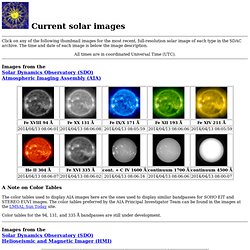

Solar images at SDAC. Click on any of the following thumbnail images for the most recent, full-resolution solar image of each type in the SDAC archive.

The time and date of each image is below the image description. All times are in coordinated Universal Time (UTC). Images from the Solar Dynamics Observatory (SDO) Atmospheric Imaging Assembly (AIA) A Note on Color Tables The color tables used to display AIA images here are the ones used to display similar bandpasses for SOHO EIT and STEREO EUVI images. Color tables for the 94, 131, and 335 Å bandpasses are still under development.
Images from the Solar Dynamics Observatory (SDO) Helioseismic and Magnetic Imager (HMI) Images from other sources Return to the home page for the SDAC. Greetings. JHelioviewer. Solar Dynamics Observatory. STS-135: The Last Shuttle Mission. ARTIS @ SolarIMG. Webcast: Watch NASA's Final Shuttle Launch LIVE via Spaceflight Now. Titan « Lights in the Dark. Illustration of a sunrise above a liquid methane lake on Titan. © Ron Miller.

All rights reserved. We’ve known for quite some time now that lakes of liquid methane and ethane exist on the frigid surface of Saturn’s overcast moon Titan. While the sheer presence of large amounts of liquid on another world is fascinating, one thing that’s particularly intrigued scientists about these hydrocarbon lakes is their uncanny stillness — in many radar images they appear to be literally as smooth as glass, with no indication of movement or wave action of any sort.
And although liquid methane isn’t water and probably behaves differently, with Titan’s substantial atmosphere it only makes sense that some sort of waves would get kicked up across lakes so vast, even from the most moderate seasonal breezes. Read the rest of this article here. Like this post? Like this: Like Loading...
Esa. JPL Small-Body Database Browser. Canada France Hawaii Telescope. CFHT Cloudcams. Home. Biggest Questions of the Universe. This is a portion of the first 360-degree view of the martian surface taken by Spirit's panoramic camera.

Part of the spacecraft can be seen in the lower part of the image. PhotoCredit: NASA/JPL/Cornell Each Friday this summer, Life's Little Mysteries presents The Greatest Mysteries of the Cosmos, starting with our solar system. Mars, the fourth planet from the Sun, gets its name from the Roman god of war on account of its blood-rust color. From an exploratory point of view, the moniker is fitting: Mars has fought off most of our scientific advances. Despite these setbacks, our curiosity regarding Mars has never abated. Abode of life? You can't talk about Mars without raising the question of life. "What everyone wants to know is: has the planet ever harbored life? " Today, and for most of its history, Mars has been a "cold, dry, desolate world," said Squyres. To make life, you (most likely) need water. Warm and wet to cold and dry A tale of two hemispheres Bonus boggler: Funky, lumpy moons. SOHO LASCO C3 Latest Image. SOHO Science Archives. Solar and Heliospheric Observatory Homepage.
Astronomy Picture of the Day. iSWACygnetStreamer (Image GIF, 960x600 pixels) The Known Universe. Index of /assets/img/browse/2011/08/08. SDO - Solar Dynamics Observatory. SDO | Data 4096 2048 1024 512 4096 PFSS 2048 PFSS 1024 PFSS 512 PFSS 48 hr MP4 4096 2048 1024 512 4096 PFSS 2048 PFSS 1024 PFSS 512 PFSS 48 hr MP4 4096 2048 1024 512 4096 PFSS 2048 PFSS 1024 PFSS 512 PFSS 48 hr MP4 4096 2048 1024 512 4096 PFSS 2048 PFSS 1024 PFSS 512 PFSS 48 hr MP4 4096 2048 1024 512 4096 PFSS 2048 PFSS 1024 PFSS 512 PFSS 48 hr MP4 4096 2048 1024 512 4096 PFSS 2048 PFSS 1024 PFSS 512 PFSS 48 hr MP4 4096 2048 1024 512 4096 PFSS 2048 PFSS 1024 PFSS 512 PFSS 48 hr MP4 4096 2048 1024 512 4096 PFSS 2048 PFSS 1024 PFSS 512 PFSS 48 hr MP4 4096 2048 1024 512 4096 PFSS 2048 PFSS 1024 PFSS 512 PFSS 48 hr MP4 HMI Magnetogram 4096 2048 1024 512 4096 PFSS 2048 PFSS 1024 PFSS 512 PFSS 48 hr MPEG HMI Colorized Magnetogram 4096 2048 1024 512 48 hr MPEG HMI Intensitygram - colored.
